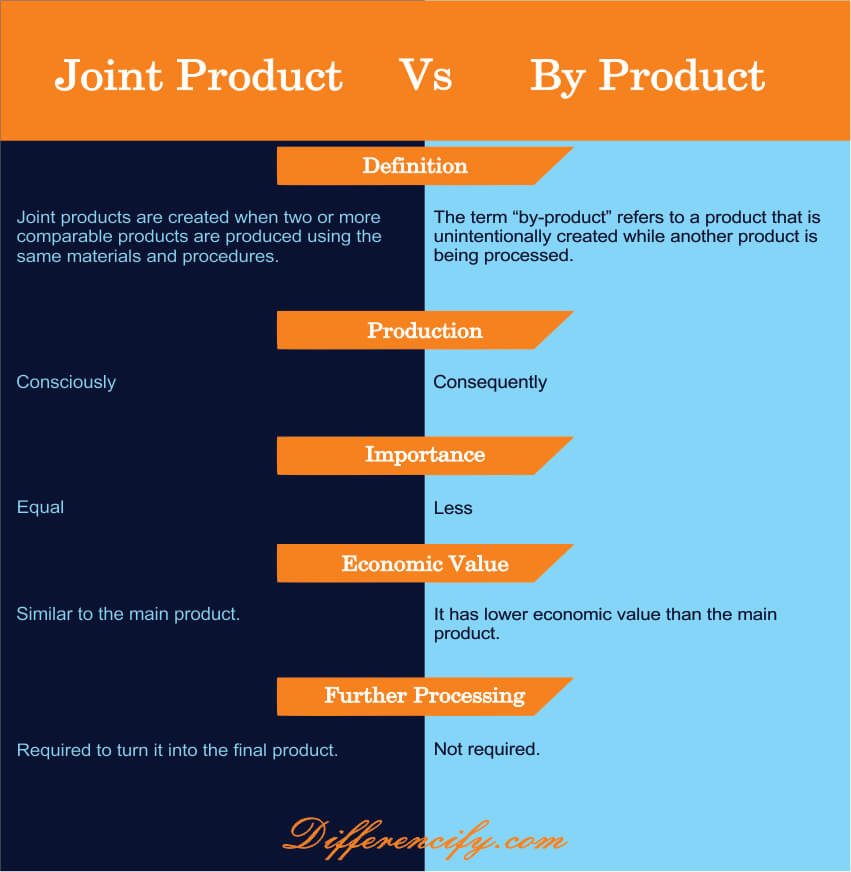Difference Between Joint Product and By-Product(With Table)
A joint product is when two or more products are created at the same time from the same raw materials and it is possible to determine what percentage of each product was created. On the other hand, a by-product is when one product is sold as a by-product of the production process for another product. Or it can be referred to as a secondary product that is unintentionally or accidentally produced in the production of another main product. The following statements will help us understand the complete difference between the joint product and by-product in detail.
What is Joint Product?
Joint product is a term used in marketing and business to describe two or more products that are jointly produced from a common raw material. In general, joint product refers to any product or service that is jointly produced or provided by two or more businesses. The term can be used to describe products that are co-branded or share common packaging, as well as services that are jointly provided.
In joint products when the raw material is processed further then it is bifurcated into two or more finished products which have different market demands and use. The main reason to further process the raw material is to separate those products which can be sold at a higher price in the market. This concept of the joint product is extensively used in the manufacturing and processing industries.
Joint products are two or more items that are produced simultaneously during the same manufacturing process. A joint product has common inputs and resources and shares a common production process up to a certain point of completion. At this point, the products diverge and become unique entities. To continue with the automobile example, steel and glass are joint products of the manufacturing process that creates them; they share inputs and resources until they reach the point where they diverge and become unique entities (a steel door frame and windshield).
What is By-Product?
In manufacturing, a by-product is defined as a secondary product derived from the primary product. The term “by-product” can also refer to a beneficial result of a process or reaction that is not the main or intended outcome. For example, water is a by-product of burning gasoline in an automobile engine.
In the meatpacking industry, by-products are defined as parts of the animal that are not used for human consumption. These by-products can include organs, bones, blood, feathers, and fatty tissue. By-products are often used in pet food or sold to rendering plants.
Moreover, by-products need to be managed in an environmentally sound manner to avoid pollution. Improperly managed by-products can contaminate water supplies and harm wildlife. Also, they need not be waste products. For example, bran, a by-product of milling flour, can be used in animal feed or sold as food for humans. They can also have economic value. For example, wool is a by-product of sheep farming that can be sold for textile production.
You Can Also Read: Difference Between Goods and Services
Comparison Table

Key Differences Between Joint Product and By-Product
- Joint Products are two or more goods that share a raw material requirement and go through the same production process up to a specific point before being sold or going through additional processing. By-product, on the other hand, refers to the items that are created alongside those with high useful value but low usable value.
- A joint product is a product that is produced by combining two or more products. In the contrast, a by-product is a product that is produced as a result of some other process.
- A joint product has an independent market value. On the other hand, by-product does not have any market value and is considered waste.
- The cost of the joint product is incurred when the production process is complete. On the other hand, the cost of the by-product is incurred during the production process only.
- The sale of joint products generates income for the company, while the sale of by-products does not generate any income.
- The production of joint products requires specialized machinery and equipment. On the other hand, the production of by-products does not require any specialized machinery or equipment.
- The quality control measures for the joint product are very strict as it has to meet the standards set by the market. On the other hand, there are no quality control measures for the by-product as it has no market value.
- The government regulations regarding the disposal of the joint product are very strict as it has to be disposed of off in a proper manner so that it does not cause pollution. On the other hand, there are no government regulations regarding the disposal of by-products.
Conclusion
So, the main difference between joint product vs by-product is that a joint product is a product that is produced along with the main product. On the other hand, a by-product is a product that is obtained as a result of the manufacturing process but has little or no value. However, both products have some sort of commercial value.



